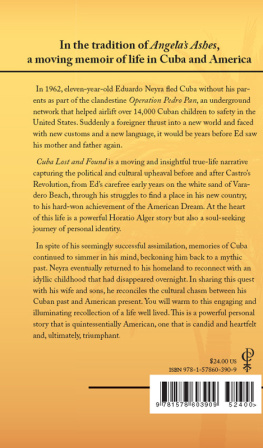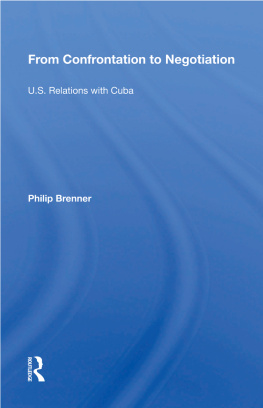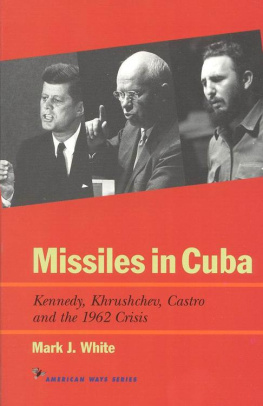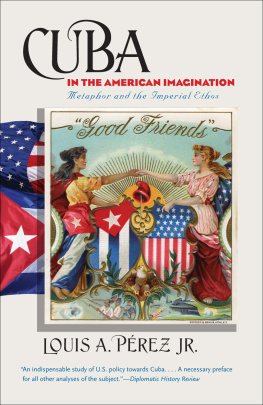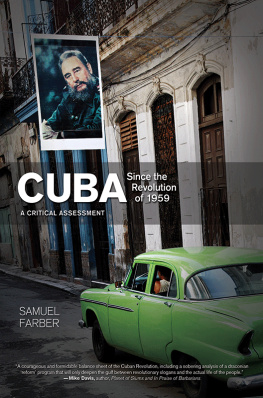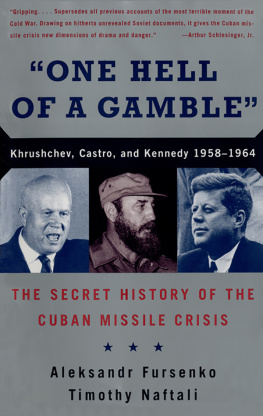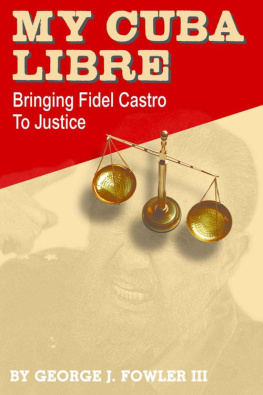


Copyright 2010 by Edward J. Neyra
All rights reserved. No portion of this book may be reproduced in any fashion, print, facsimile, or electronic, or by any method yet to be developed, without express permission of the copyright holder.
Published by Clerisy Press
Printed in the United States of America
Distributed by Publishers Group West
First edition, first printing
For further information, contact the publisher at:
Clerisy Press
PO Box 8874
Cincinnati, OH 45208-08074
www.clerisypress.com
Library of Congress Cataloging-in-Publication Data
Neyra, Edward J.
Cuba, lost and found / by Edward J. Neyra.
p. cm.
ISBN-13: 978-1-57860-390-9
ISBN-10: 1-57860-390-0
1. Neyra, Edward J. 2. Neyra, Edward J.Childhood and youth. 3. Cuban AmericansBiography. 4. ImmigrantsUnited States Biography. 5. Operation Peter Pan. 6. Cincinnati (Ohio)Biography. 7. CubaBiography. 8. CubaHistoryRevolution, 1959. I. Title.
E184.C97N49 2009
972.91dc22
2009031060
Edited by Richard Hunt and Teresa Lewis
Cover designed by Jim Fenster, MillerMyers Design Group
Cover painting by Lynn B. Neyra
Text designed by Annie Long
All other photos provided courtesy of Edward J. Neyra
D EDICATION
To my dear mother, for her unconditional love and enormous courage

Maria Caridad Neyra Prez
P REFACE
i began to write this book to document my journey as a Cuban immigrant and build a bridge between my parents world of the past and my childrens world of the future. I felt a responsibility to take this thin thread that still ran through my life and recreate the fabric of my Cuban heritage for my American sons.
But along the way what seemed to be a simple, straightforward task became something far richer and much more intriguing. I thought I was tying together a few loose strings, but what I discovered was a colorful, ancient tapestry, and my own doubts and demons were woven within its shadowy folds.
I have constructed this story to the best of my own recollection with extensive research and the help of family and friends. I am very aware of the importance of accuracy and the inherent responsibility when writing about other peoples lives as well as my own, so some names have been changed to protect the privacy of those individuals. Also, please keep in mind that time dilutes memories, even if the emotional imprint of the event seems indelible.
It is imperative that as you read this book, you are aware that the facts, figures and conditions presented regarding Cuba are based on my own observations from the time period in which I visited the island, beginning in the mid-nineties. As we all know, the economic conditions and political policies within both Cuba and the United States, as well as the relationship between the two countries, have changed over time and will continue to do so.

Celebrating Independence Day in Cincinnati, Ohio, July 1962
Often I think of the beautiful town
That is seated by the sea;
Often in thought go up and down
The pleasant streets of that dear old town,
And my youth comes back to me.
And a verse of a Lapland song
Is haunting my memory still:
A boys will is the winds will,
And the thoughts of youth are long, long thoughts.
from My Lost Youth
by Henry Wadsworth Longfellow

C AUGHT IN THE C ROSSFIRE
t he peril of living in the midst of a revolution was swiftly delivered to my doorstep one tumultuous spring day in 1957 when I was just seven years old. A student activist from my hometown of Crdenas, Jos Antonio Echevarra, had been shot and killed in Havana during a failed coup attempt against dictator Fulgencio Batista. Echevarras body had been brought home for burial and as his funeral procession passed by, I had an ideal view from our home on Calle Calzada , the main artery that connected the center of town to the rural cemetery. Never before had so many people marched past our front door, and the lines went on for blocks. It seemed as if the entire city was dressed in black, following his casket on foot. There had been an overwhelming outcry after the outspoken students slaughter, and the processional had become a political statement protesting Batistas cruel dictatorship.
Suddenly, right over our roof, rapid gunfire from a low-flying helicopter buzzed the processional, shattering the respectful silence. The solid mass of mourners scattered as most dove for cover. Some scrambled into San Antonio church on the corner. Others jammed themselves into a small grocery store across the street or into any home with an open door. But a devoted core defiantly continued to follow the slow-moving hearse.
In the whirlwind of confusion I lost my grip on our front door and found myself locked out and swept into the turbulent current of the fleeing crowd. I kept ducking and searching for shelter, while the rapid fire of the machine guns spattered overhead. The mechanical roar of the flying predator intensified the terror caused by the angry and incessant bullets. Suddenly, I saw salvation.
Teresa Cruz, the midwife at my birth, stood in the open doorway of her house across the street. I can still see her clearly outlined therewearing her white nurses uniform, appearing like a guardian angel. She was guiding people into her home, so I bolted through the crowd and into her living room.
It all happened so fast, but it seemed to unfold in slow motion. Amid the noise and confusion my mother had discovered I was missing. I could barely hear her hysterical cry, Eduardito! Eduardito! Eduardito!
Mami, I am here, at Teresas house! I shouted in reply.
She frantically darted back and forth on the sidewalk, but she could not hear me. Finally, Mami heard Teresa yell her nickname, Cuca! Cuca! He is here with me! Go back home!
Instead, Mami lunged across the street, ignoring the deadly flying bullets, her face covered in tears. She burst through Teresas door, relieved and overjoyed. We embraced, and she held me close while we waited for the chaos to wane, as if pausing under a shelter during a tropical cloudburst.
These political thunderstorms were nothing new to our island paradise. Cuba comes from the word cubanacan , which meant the center place to the indigenous Tano Indians, and for centuries, the island claimed center stage in the Caribbean. Due to its size and strategic location, the Pearl of the Antilles was coveted as an irresistible jewel to many world powers, from the Spanish conquistadors to the Communists of the Soviet Union. For over five hundred years, Cuba has found herself repeatedly embroiled in the center of world conflict and torn internally by struggles between corrupt leaders who enriched themselves at the expense of the countrys political, economic and social stability.
Next page
